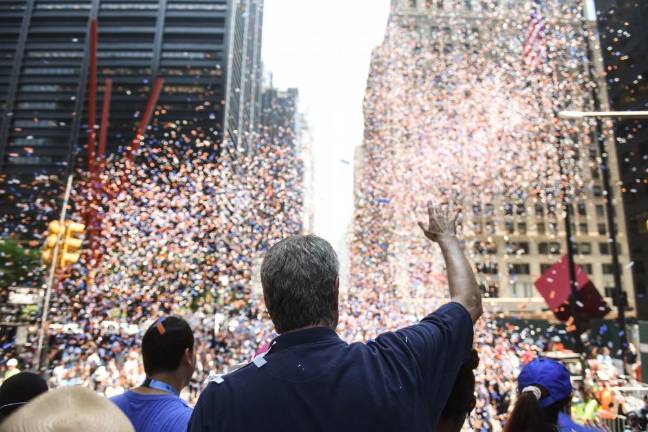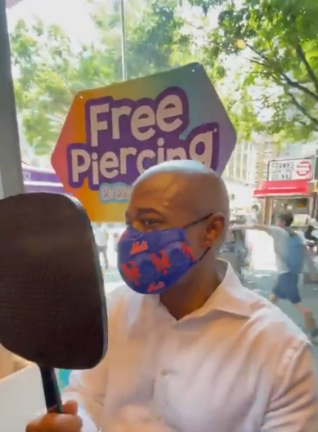Passing the Torch
After Bill de Blasio, Mayor Presumptive Eric Adams has an opportunity to consolidate a battered city behind him. A look at some building blocks for the long interregnum


You can scour the City Charter, but no where will you find the job of Mayor Presumptive. Yet, Eric Adams has taken up that role. Before he gets to grapple with the challenges of his first 100 days, he must navigate these 178 days as Mayor-in-Waiting.
Adams, an intuitive politician, seemed to quickly grasp that the success of the mayoralty he will not officially win until November may well hang on how well he uses this long and unusual interregnum.
Journalistic convention requires the caveat here that Adams ascension to office presumes no more unforeseen twists in a period of New York history that has already provided many. He must still dispatch his Republican opponent, Curtis Sliwa.
But unlike years in which the general election has been a real contest (producing Republican winners from Lindsay through Bloomberg and Giuliani), this year it is an opportunity for Adams to consolidate a dazed and battered city behind him and the mission of recovery.
Adams highlighted “the uniqueness of this moment” in laying claim to the Democratic nomination. “I call it Esther 4:14,” he said, invoking the old testament story of Queen Esther finding the courage to act. “God made me for such a time like this.”
Clearly, this former police captain does not lack a sense of mission. His test between now and next January will be whether he can translate that into the political unity and managerial acumen he will need on day one as mayor.
Bridge Building
Adams won a clear but narrow victory. Large parts of the Democratic base were unconvinced. Kathryn Garcia trounced Adams among the white gentry of Manhattan and Brownstone Brooklyn. At the same time, many progressives refused to even rank him on their ballots, giving Garcia a huge boost when Maya Wiley was eliminated in the ranked choice tabulation and half her vote went to Garcia.
Adams has made clear he intends to be the Mayor of “working class” New York. His success will rest, however, on his skill at forging alliances as he needs them with constituencies that have been more skeptical. He will have an opportunity to use the general election campaign to speak past his official opponents to the entire city, which of course also includes large numbers who consider themselves independents or Republicans.
Administration Building
Adams clearly has a theatrical flair to rival John Lindsay or Ed Koch. As a state senator he made a video coaching parents on how to search their kids’ stuff for contraband. He has promised the press they won’t be bored.
On the morning after his victory he had his left ear pierced to fulfill a commitment he made on the campaign trail to a young man who wanted to test if he was like other politicians who made promises and then ignored them.
“I told you I was going to do it and I just did what I promised,” he said in a video posted to social media. “Day one, living up to my promises.”
But his embrace of this public-facing role is only half of what a mayor needs to do. The other half is run a government.
The long interregnum is a rare gift if Adams uses it to organize an administration that can get off to a flying start next January. He has already announced he plans to name a woman police commissioner, a job crucial to fulfilling his campaign pledge to curb crime and hold police accountable.
Yet, while debate around policing dominated the campaign, to secure the city’s future Adams will also need strong figures in public health, economic development, finance and education. The publisher Tom Allon has suggested that Adams assemble a “team of rivals” by inviting defeated opponents, including Garcia and Wiley, into the administration.
De Blasio Building
The now lame duck mayor, Bill de Blasio, has expressed a kind of narcissistic praise for Adams, noting that their electoral coalitions were similar. Perhaps so. If de Blasio truly supports Adams he can do a lot to help him get off to a strong start. Or he can allow problems to build in a way that could drag Adams down in a year or two.
The city’s basic recovery challenge is difficult, but not hard to describe. Both the economy and the city government are being propped up by large amounts of federal stimulus revenue. When that federal money runs out the city will fall into a deep hole unless costs have been cut or jobs and tax revenue have been restored to pre- pandemic levels (or a combination of both).
De Blasio can do Adams a real solid by getting that process well underway before leaving office. Or he can do what he is currently doing, enacting the largest budget in city history with no clear plan for what happens when the federal dollars are gone.
Self Building
Adams offers a man who made and then remade himself. “I didn’t say, ‘Woe is me.’ I said, ‘Why not me.’
Yet nothing he has been through prepares him for the transition he now undertakes. Running a police precinct is a significant management challenge. But nothing compared to running a city of more than 8 million souls.
Adams has clearly enjoyed his star turn on his suddenly expanded stage. He cleverly encouraged the view of his victory as what The Economist, weighing in from London, called “a rebuke to the progressive zeal that has overtaken America’s largest cities.”
New York is a global city and its Mayor Presumptive rightly draws global attention. Adams has no previous experience in maintaining his purpose amidst all these bright lights.
“He promises to be mayor for the Bronx and Brooklyn, not the Upper West side,” The Economist said for him. In fact, he is Mayor Presumptive of all New York. His predecessor’s Tale of Two Cities turned out to be words without progress for the very people he was purporting to help. If Adams has made anything clear it is that he wants results – lower crime, more jobs, better schools — more than words.
Early in his campaign, Adams read Eleanor Randolph’s biography of Mike Bloomberg, according to a New Yorker who speaks with him, and then told members of his inner circle that he’d like to emulate Bloomberg’s management style.
“I know how we can turn around not only New York but America,” Adams said after the votes were counted. “We’re in a terrible place, and we can turn this country, this city around.”
The publisher Tom Allon has suggested that Adams assemble a “team of rivals’ by inviting defeated opponents, including Garcia and Wiley, into the administration.